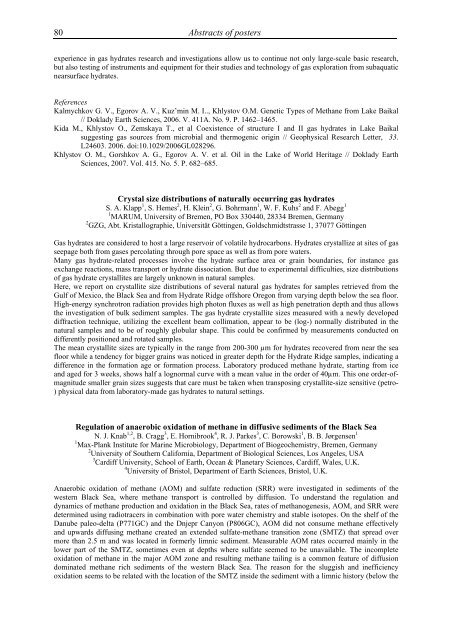Ninth international conference on - Marum
Ninth international conference on - Marum
Ninth international conference on - Marum
You also want an ePaper? Increase the reach of your titles
YUMPU automatically turns print PDFs into web optimized ePapers that Google loves.
80<br />
Abstracts of posters<br />
experience in gas hydrates research and investigati<strong>on</strong>s allow us to c<strong>on</strong>tinue not <strong>on</strong>ly large-scale basic research,<br />
but also testing of instruments and equipment for their studies and technology of gas explorati<strong>on</strong> from subaquatic<br />
nearsurface hydrates.<br />
References<br />
Kalmychkov G. V., Egorov A. V., Kuz’min M. I.., Khlystov O.M. Genetic Types of Methane from Lake Baikal<br />
// Doklady Earth Sciences, 2006. V. 411A. No. 9. P. 1462–1465.<br />
Kida M., Khlystov O., Zemskaya T., et al Coexistence of structure I and II gas hydrates in Lake Baikal<br />
suggesting gas sources from microbial and thermogenic origin // Geophysical Research Letter, 33.<br />
L24603. 2006. doi:10.1029/2006GL028296.<br />
Khlystov O. M., Gorshkov A. G., Egorov A. V. et al. Oil in the Lake of World Heritage // Doklady Earth<br />
Sciences, 2007. Vol. 415. No. 5. P. 682–685.<br />
Crystal size distributi<strong>on</strong>s of naturally occurring gas hydrates<br />
S. A. Klapp 1 , S. Hemes 2 , H. Klein 2 , G. Bohrmann 1 , W. F. Kuhs 2 and F. Abegg 1<br />
1 MARUM, University of Bremen, PO Box 330440, 28334 Bremen, Germany<br />
2 GZG, Abt. Kristallographie, Universität Göttingen, Goldschmidtstrasse 1, 37077 Göttingen<br />
Gas hydrates are c<strong>on</strong>sidered to host a large reservoir of volatile hydrocarb<strong>on</strong>s. Hydrates crystallize at sites of gas<br />
seepage both from gases percolating through pore space as well as from pore waters.<br />
Many gas hydrate-related processes involve the hydrate surface area or grain boundaries, for instance gas<br />
exchange reacti<strong>on</strong>s, mass transport or hydrate dissociati<strong>on</strong>. But due to experimental difficulties, size distributi<strong>on</strong>s<br />
of gas hydrate crystallites are largely unknown in natural samples.<br />
Here, we report <strong>on</strong> crystallite size distributi<strong>on</strong>s of several natural gas hydrates for samples retrieved from the<br />
Gulf of Mexico, the Black Sea and from Hydrate Ridge offshore Oreg<strong>on</strong> from varying depth below the sea floor.<br />
High-energy synchrotr<strong>on</strong> radiati<strong>on</strong> provides high phot<strong>on</strong> fluxes as well as high penetrati<strong>on</strong> depth and thus allows<br />
the investigati<strong>on</strong> of bulk sediment samples. The gas hydrate crystallite sizes measured with a newly developed<br />
diffracti<strong>on</strong> technique, utilizing the excellent beam collimati<strong>on</strong>, appear to be (log-) normally distributed in the<br />
natural samples and to be of roughly globular shape. This could be c<strong>on</strong>firmed by measurements c<strong>on</strong>ducted <strong>on</strong><br />
differently positi<strong>on</strong>ed and rotated samples.<br />
The mean crystallite sizes are typically in the range from 200-300 µm for hydrates recovered from near the sea<br />
floor while a tendency for bigger grains was noticed in greater depth for the Hydrate Ridge samples, indicating a<br />
difference in the formati<strong>on</strong> age or formati<strong>on</strong> process. Laboratory produced methane hydrate, starting from ice<br />
and aged for 3 weeks, shows half a lognormal curve with a mean value in the order of 40µm. This <strong>on</strong>e order-ofmagnitude<br />
smaller grain sizes suggests that care must be taken when transposing crystallite-size sensitive (petro-<br />
) physical data from laboratory-made gas hydrates to natural settings.<br />
Regulati<strong>on</strong> of anaerobic oxidati<strong>on</strong> of methane in diffusive sediments of the Black Sea<br />
N. J. Knab 1,2 , B. Cragg 3 , E. Hornibrook 4 , R. J. Parkes 3 , C. Borowski 1 , B. B. Jørgensen 1<br />
1 Max-Plank Institute for Marine Microbiology, Department of Biogeochemistry, Bremen, Germany<br />
2 University of Southern California, Department of Biological Sciences, Los Angeles, USA<br />
3 Cardiff University, School of Earth, Ocean & Planetary Sciences, Cardiff, Wales, U.K.<br />
4 University of Bristol, Department of Earth Sciences, Bristol, U.K.<br />
Anaerobic oxidati<strong>on</strong> of methane (AOM) and sulfate reducti<strong>on</strong> (SRR) were investigated in sediments of the<br />
western Black Sea, where methane transport is c<strong>on</strong>trolled by diffusi<strong>on</strong>. To understand the regulati<strong>on</strong> and<br />
dynamics of methane producti<strong>on</strong> and oxidati<strong>on</strong> in the Black Sea, rates of methanogenesis, AOM, and SRR were<br />
determined using radiotracers in combinati<strong>on</strong> with pore water chemistry and stable isotopes. On the shelf of the<br />
Danube paleo-delta (P771GC) and the Dnjepr Cany<strong>on</strong> (P806GC), AOM did not c<strong>on</strong>sume methane effectively<br />
and upwards diffusing methane created an extended sulfate-methane transiti<strong>on</strong> z<strong>on</strong>e (SMTZ) that spread over<br />
more than 2.5 m and was located in formerly limnic sediment. Measurable AOM rates occurred mainly in the<br />
lower part of the SMTZ, sometimes even at depths where sulfate seemed to be unavailable. The incomplete<br />
oxidati<strong>on</strong> of methane in the major AOM z<strong>on</strong>e and resulting methane tailing is a comm<strong>on</strong> feature of diffusi<strong>on</strong><br />
dominated methane rich sediments of the western Black Sea. The reas<strong>on</strong> for the sluggish and inefficiency<br />
oxidati<strong>on</strong> seems to be related with the locati<strong>on</strong> of the SMTZ inside the sediment with a limnic history (below the














